Whether you’re a student considering career options, a professional looking to pivot into a new field, or simply curious about the science behind today’s biological innovations, understanding the nuances between biotechnology and bioengineering provides valuable insight into how these disciplines are transforming our world.
Defining Biotechnology and Bioengineering
Modern biotechnology combines molecular biology techniques with technological applications
Biotechnology and bioengineering, while closely related, represent distinct approaches to applying biological knowledge for practical purposes. Understanding their core definitions and fundamental differences is essential for appreciating their unique contributions to science and society.
What is Biotechnology?
Biotechnology can be defined as the use of living organisms, cells, or biological systems to develop products and technologies that benefit humanity. It involves manipulating biological processes at the molecular level to create useful products or solve specific problems. The field integrates knowledge from biology, chemistry, physics, and computer science to harness the power of natural biological systems.
At its core, biotechnology focuses on understanding and utilizing the inherent capabilities of biological systems. Rather than building new biological components from scratch, biotechnologists typically modify existing biological systems to perform specific functions or produce desired outcomes.
What is Bioengineering?
Bioengineering, also known as biological engineering, applies engineering principles and design concepts to biological systems. It involves the creation of new biological entities, devices, or processes through the application of engineering methodologies. Bioengineers approach biological challenges from an engineering perspective, focusing on designing and building biological systems rather than simply modifying existing ones.
The field emphasizes the systematic design of biological components, often drawing inspiration from traditional engineering disciplines such as mechanical, electrical, and chemical engineering. Bioengineers work at the interface of biology and engineering, creating innovative solutions to complex biological problems.
Key Characteristics of Biotechnology
- Utilizes existing biological systems
- Focuses on modification and optimization
- Emphasizes product development
- Primarily application-oriented
- Interdisciplinary approach combining biology and technology
Key Characteristics of Bioengineering
- Designs new biological systems
- Applies engineering principles to biology
- Emphasizes process development
- Combines fundamental and applied research
- Integrates biology with multiple engineering disciplines
Deepen Your Understanding of These Fields
Want to explore the differences between biotechnology and bioengineering in greater detail? Download our comprehensive guide that includes career pathways, educational requirements, and industry insights.
Real-World Applications and Impact
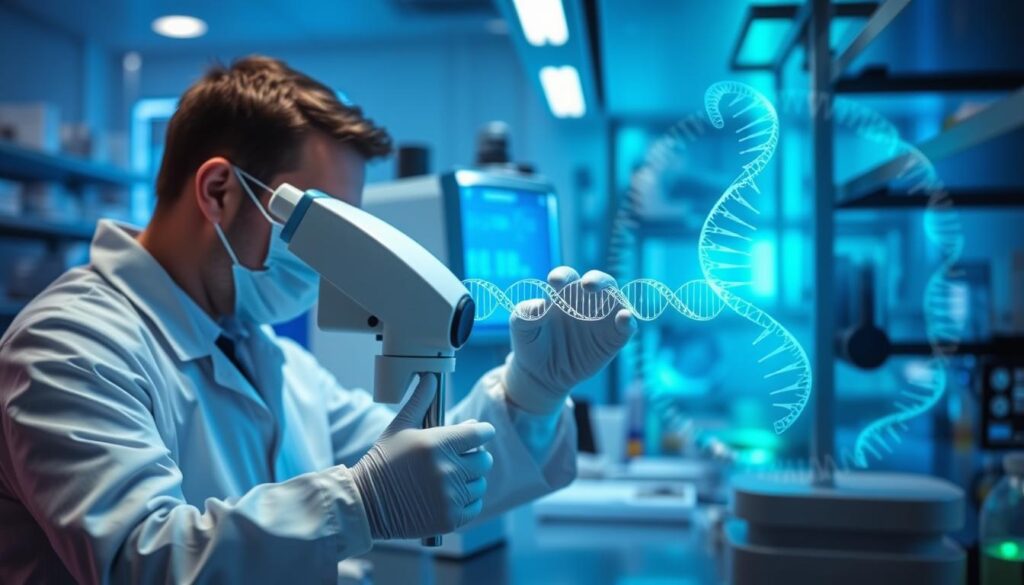
CRISPR gene editing represents one of biotechnology’s most revolutionary applications
Both biotechnology and bioengineering have produced remarkable innovations that have transformed various sectors, from healthcare and agriculture to environmental conservation and industrial manufacturing. Examining their real-world applications provides insight into how these fields differ in their approaches and impacts.
Biotechnology Applications
Biotechnology has revolutionized numerous industries through its ability to harness and modify biological processes for specific purposes. Some of its most significant applications include:
Medical Biotechnology
In healthcare, biotechnology has enabled the development of targeted therapies, diagnostic tools, and preventive measures that have transformed patient care. CRISPR-Cas9 gene editing technology represents one of the most groundbreaking advances in this area, allowing scientists to modify DNA with unprecedented precision. This technology has opened new possibilities for treating genetic disorders by directly correcting disease-causing mutations.
Another example is the production of recombinant insulin for diabetes treatment. Before biotechnology, insulin was extracted from animal pancreases, which often caused allergic reactions. Today, genetically engineered bacteria produce human insulin, providing a safer and more reliable treatment option for millions of diabetic patients worldwide.
Agricultural Biotechnology
Biotechnology has significantly impacted agriculture through the development of genetically modified organisms (GMOs) designed to increase crop yields, enhance nutritional content, and improve resistance to pests and environmental stressors. Golden Rice, engineered to produce beta-carotene, addresses vitamin A deficiency in developing countries. Similarly, Bt cotton, which produces its own insecticide, has reduced the need for chemical pesticides while increasing crop yields.
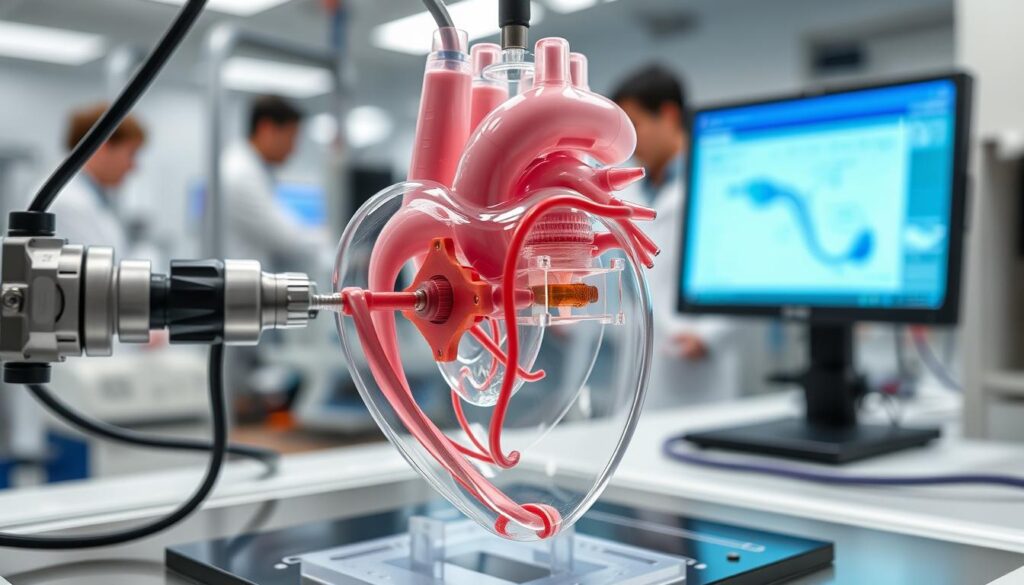
Bioengineered artificial heart valves represent significant advances in medical device technology
Bioengineering Applications
Bioengineering applies engineering principles to create innovative biological systems and devices that address complex challenges. Its applications span multiple domains:
Tissue Engineering and Regenerative Medicine
Bioengineers have made remarkable progress in developing artificial tissues and organs to address the shortage of donor organs for transplantation. 3D bioprinting technology allows for the creation of complex tissue structures by precisely depositing layers of cells and supporting materials. Researchers have successfully bioprinted functional skin grafts for burn victims, providing a more effective treatment option than traditional skin grafts.
Another significant achievement is the development of lab-grown bladders. Dr. Anthony Atala and his team at Wake Forest Institute for Regenerative Medicine created functional bladders using patients’ own cells grown on biodegradable scaffolds. These engineered organs have been successfully implanted in patients with end-stage bladder disease, demonstrating the potential of bioengineered organs to transform transplant medicine.
Biomechanical Engineering
Bioengineers design and develop mechanical devices that interface with biological systems to restore or enhance function. Advanced prosthetic limbs with neural interfaces represent a remarkable achievement in this area. These prosthetics can interpret electrical signals from remaining muscles or nerves, allowing users to control their artificial limbs through thought, much like natural limbs.
| Field | Primary Focus | Key Applications | Notable Examples |
| Biotechnology | Modifying existing biological systems | Pharmaceuticals, agriculture, industrial processes | CRISPR gene editing, recombinant insulin, GMO crops |
| Bioengineering | Designing new biological systems and devices | Medical devices, tissue engineering, biomechanics | 3D bioprinted organs, neural prosthetics, artificial heart valves |
Explore Educational Opportunities
Interested in pursuing a career in biotechnology or bioengineering? Request information about degree programs, specializations, and career outcomes from leading institutions.
Ethical Implications and Considerations

Ethics committees play a crucial role in evaluating the implications of biotechnology and bioengineering advances
As biotechnology and bioengineering continue to advance, they raise important ethical questions that society must address. These ethical considerations often differ between the two fields due to their distinct approaches and applications.
Ethical Considerations in Biotechnology
Biotechnology’s ability to manipulate genetic material and create genetically modified organisms has sparked significant ethical debates. These concerns center around several key issues:
Genetic Modification and Engineering
The ability to alter the genetic makeup of organisms raises profound ethical questions about the boundaries of human intervention in nature. CRISPR technology, which allows for precise gene editing, has intensified these debates. While it offers potential treatments for genetic diseases, concerns about “designer babies” and eugenics have emerged. The case of He Jiankui, who created the first genetically edited babies in 2018, highlighted the ethical challenges of applying gene editing to human embryos without adequate oversight or consensus on acceptable applications.
In agriculture, genetically modified crops have generated controversy regarding their long-term environmental impact and potential health effects. The debate extends to questions about biodiversity loss, ecosystem disruption, and the concentration of power in the hands of corporations that control patented GMO seeds.
Intellectual Property and Access
The patenting of biotechnological innovations raises questions about ownership of biological materials and processes. The landmark case of Myriad Genetics, which patented the BRCA1 and BRCA2 genes associated with breast cancer, sparked debate about whether naturally occurring genetic sequences should be patentable. The Supreme Court’s 2013 ruling that naturally occurring DNA sequences cannot be patented reshaped the biotechnology intellectual property landscape.
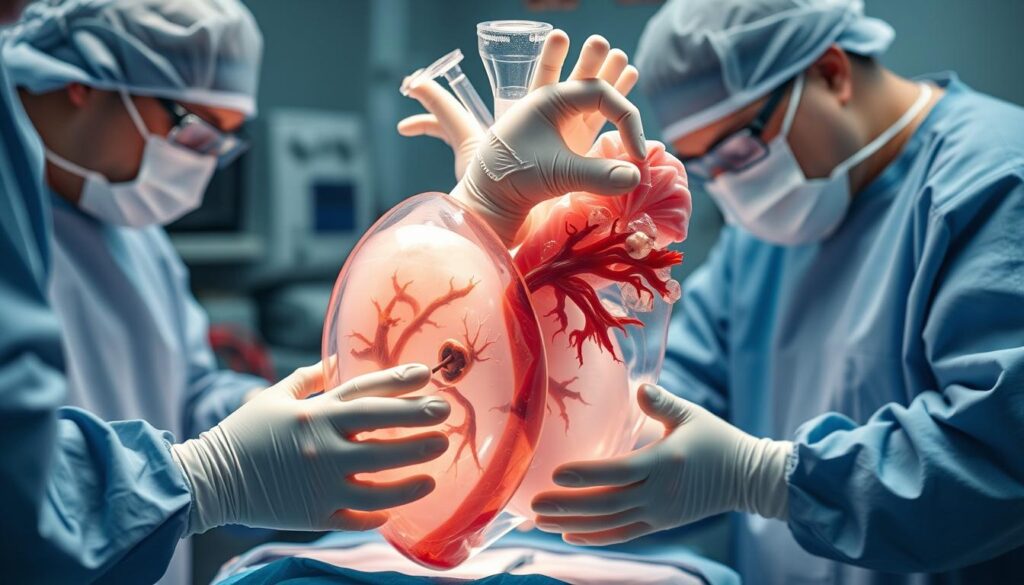
Bioengineered organs raise questions about equitable access to advanced medical technologies
Ethical Considerations in Bioengineering
Bioengineering’s focus on creating new biological systems and devices presents its own set of ethical challenges:
Human Enhancement and Identity
Bioengineered devices and systems that enhance human capabilities raise questions about what it means to be human. Neural interfaces that connect the brain directly to computers or prosthetics that exceed the capabilities of natural limbs blur the line between human and machine. The development of exoskeletons that enhance strength or endurance for military applications raises concerns about creating “super soldiers” and the potential for an arms race in human enhancement technologies.
These technologies also raise issues of equity and access. If enhancement technologies are available only to the wealthy, they could exacerbate existing social inequalities and create new forms of discrimination based on enhanced versus unenhanced individuals.
Synthetic Biology and Creating Life
Bioengineers working in synthetic biology aim to design and construct new biological parts, devices, and systems that do not exist in nature. The creation of the first synthetic bacterial genome by the J. Craig Venter Institute in 2010 demonstrated the possibility of creating artificial life forms. This capability raises profound questions about the definition of life, the responsibilities of creating new life forms, and the potential ecological impacts of releasing synthetic organisms into the environment.
Ethical Frameworks Supporting Innovation
- Principle of beneficence: Technologies that alleviate suffering and improve quality of life
- Autonomy: Respecting individual choice in using biotechnologies
- Justice: Ensuring equitable access to beneficial technologies
- Scientific freedom: Allowing exploration that advances knowledge
Ethical Concerns Requiring Caution
- Non-maleficence: Avoiding harm to individuals and ecosystems
- Dignity: Preserving human uniqueness and integrity
- Precautionary principle: Proceeding cautiously with irreversible changes
- Intergenerational justice: Considering impacts on future generations
As these fields continue to advance, developing robust ethical frameworks and regulatory approaches becomes increasingly important. Balancing innovation with responsible development requires ongoing dialogue among scientists, ethicists, policymakers, and the public to ensure that these powerful technologies serve humanity’s best interests.
Explore Ethical Perspectives
Interested in delving deeper into the ethical dimensions of biotechnology and bioengineering? Access our curated collection of articles, case studies, and expert opinions on these complex issues.
Emerging Trends and Future Directions
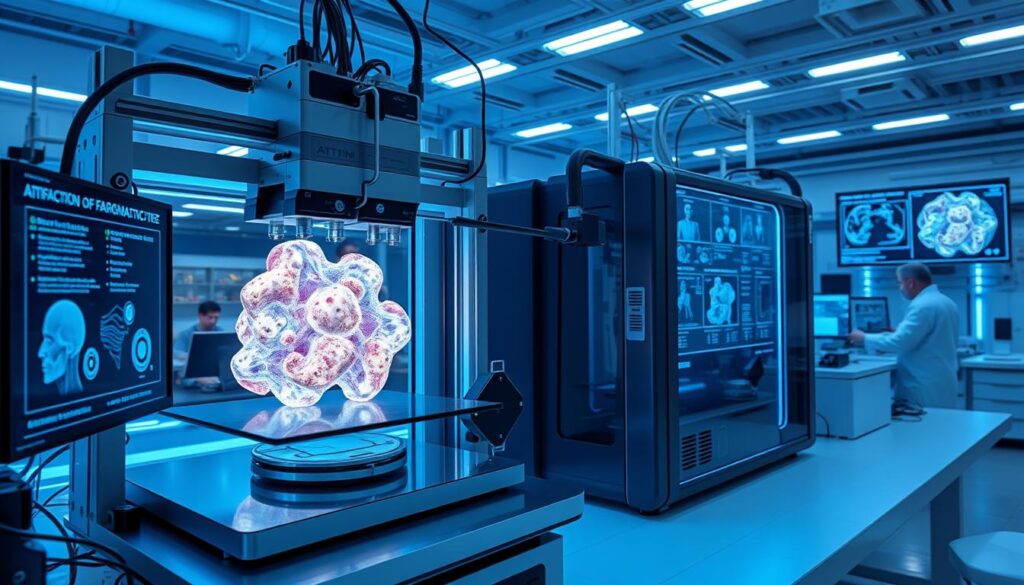
AI-driven biofabrication represents a convergence of artificial intelligence and biological engineering
Both biotechnology and bioengineering are experiencing rapid evolution, driven by technological advances and interdisciplinary collaboration. Examining emerging trends provides insight into how these fields are likely to develop in the coming years and how they might increasingly converge.
Emerging Trends in Biotechnology
Biotechnology continues to expand its capabilities through integration with other cutting-edge technologies and disciplines:
Synthetic Biology and Metabolic Engineering
Synthetic biology is revolutionizing biotechnology by enabling the design and construction of new biological parts, devices, and systems. Metabolic engineering, a subset of this field, focuses on optimizing cellular metabolic pathways to produce valuable compounds. Companies like Ginkgo Bioworks have engineered microorganisms to produce fragrances, flavors, and other high-value chemicals that were previously derived from plants or petroleum.
A notable example is the production of artemisinic acid, a precursor to the antimalarial drug artemisinin. Researchers engineered yeast to produce this compound, which was traditionally extracted from sweet wormwood plants. This biotechnological approach has helped stabilize the supply of this critical medication, potentially saving millions of lives in regions where malaria is endemic.
Computational Biotechnology and AI Integration
Artificial intelligence and machine learning are transforming biotechnology by accelerating drug discovery, optimizing bioprocesses, and predicting protein structures. DeepMind’s AlphaFold has revolutionized protein structure prediction, solving a 50-year-old grand challenge in biology. This breakthrough enables researchers to better understand protein function and design more effective drugs.
In drug discovery, companies like Recursion Pharmaceuticals use AI to analyze vast datasets of cellular images to identify potential therapeutic compounds. This approach has identified promising drug candidates for rare diseases in a fraction of the time required by traditional methods.
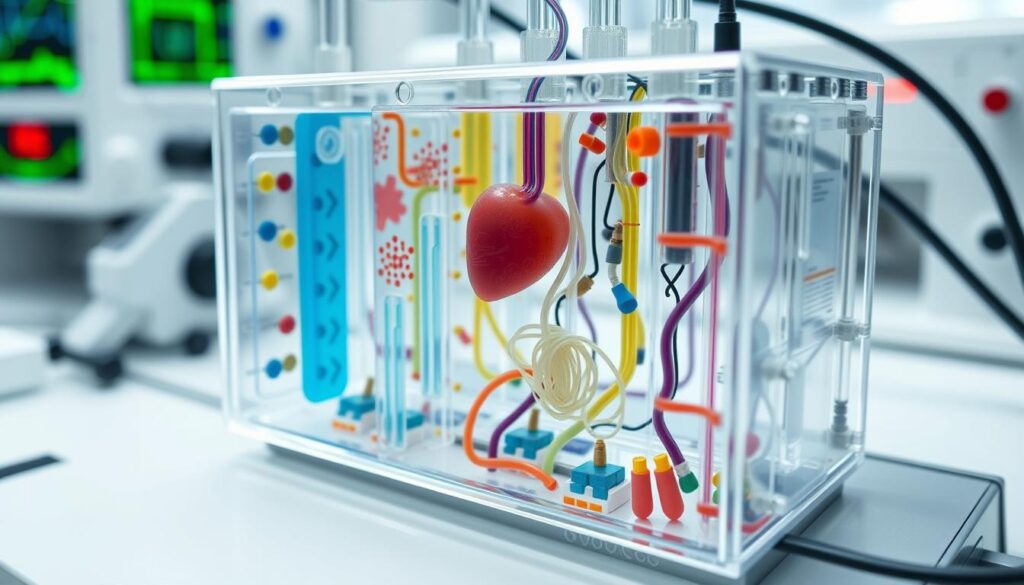
Organ-on-a-chip technology enables testing of drugs and treatments on miniaturized human organ systems
Emerging Trends in Bioengineering
Bioengineering is pushing boundaries through innovative approaches to creating and interfacing with biological systems:
Precision Bioengineering and Nanomedicine
Advances in nanoscale engineering are enabling unprecedented precision in biomedical interventions. Nanoparticles designed for targeted drug delivery can now navigate the body’s complex environment to deliver therapeutics directly to disease sites, minimizing side effects and maximizing efficacy. Researchers at MIT have developed nanoparticles that can cross the blood-brain barrier to deliver treatments for neurological conditions that were previously difficult to address.
Microfluidic organ-on-a-chip technology represents another breakthrough in precision bioengineering. These devices contain living human cells arranged to mimic the function of organs, allowing researchers to test drugs and study disease mechanisms in a more physiologically relevant context than traditional cell cultures or animal models. The Wyss Institute’s lung-on-a-chip, which recreates the mechanical and biochemical behaviors of a human lung, exemplifies this approach.
Neural Engineering and Brain-Computer Interfaces
Neural engineering is advancing rapidly, with brain-computer interfaces (BCIs) showing promise for treating neurological conditions and enhancing human capabilities. Companies like Neuralink are developing implantable devices that can record and stimulate brain activity, potentially treating conditions like paralysis, blindness, and depression.
Beyond medical applications, BCIs may eventually enable direct brain-to-computer communication, allowing users to control digital devices with their thoughts. While still in early stages, this technology could fundamentally transform how humans interact with technology and each other.
Convergent Technologies
- AI-driven protein design
- Digital twins of biological systems
- Quantum biology applications
- Bioelectronic interfaces
Emerging Applications
- Personalized medicine platforms
- Sustainable biomanufacturing
- Engineered living materials
- Neuromorphic computing
Future Challenges
- Regulatory frameworks for novel biologics
- Standardization of bioengineered components
- Ethical governance of emerging biotechnologies
- Equitable access to advanced therapies
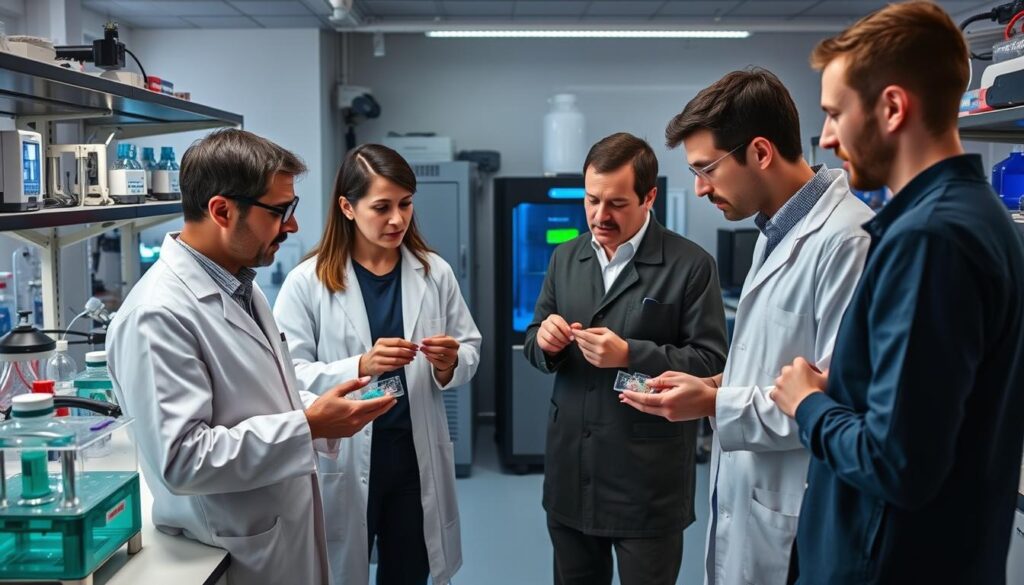
The future will likely see increasing convergence between biotechnology and bioengineering approaches
Convergence and Integration
Perhaps the most significant trend is the increasing convergence of biotechnology and bioengineering. As these fields advance, the boundaries between them are becoming less distinct, leading to powerful new approaches that combine the strengths of both disciplines.
This convergence is evident in areas like cell-free synthetic biology, which applies engineering principles to create biological systems outside of living cells. These systems can produce proteins, detect pathogens, or synthesize chemicals without the constraints of cellular metabolism, combining biotechnology’s molecular tools with bioengineering’s design approach.
Similarly, the field of biofabrication integrates biotechnological methods for manipulating cells and tissues with bioengineering approaches to creating three-dimensional structures. This convergence enables the creation of increasingly complex tissues and organs that more accurately mimic their natural counterparts.
Stay Updated on Emerging Trends
The fields of biotechnology and bioengineering are evolving rapidly. Subscribe to our newsletter to receive regular updates on breakthrough research, emerging applications, and industry developments.
Education and Career Pathways
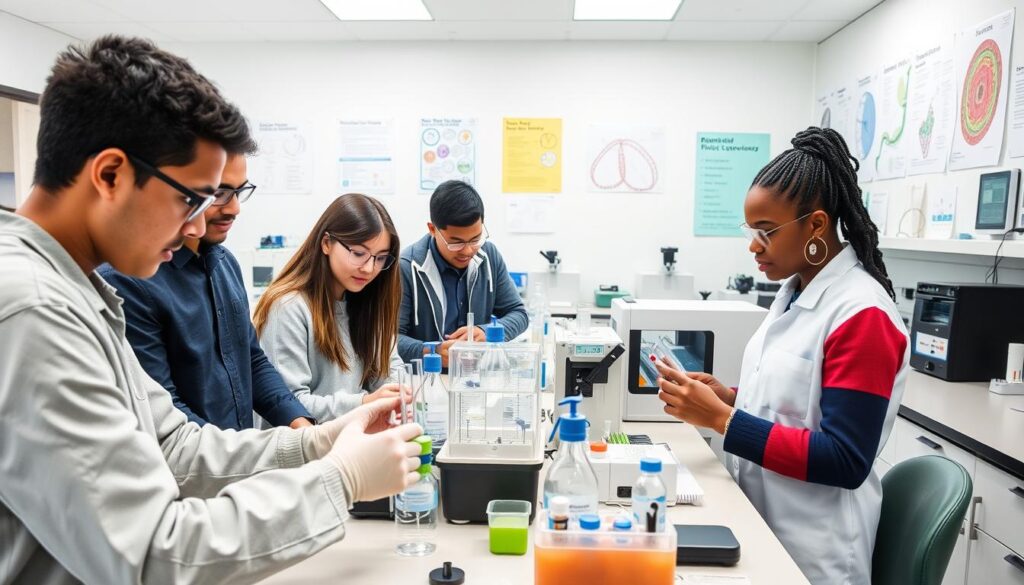
Educational programs increasingly offer interdisciplinary training in both biotechnology and bioengineering
For those interested in pursuing careers in biotechnology or bioengineering, understanding the educational pathways and career opportunities in each field is essential. While there are distinct educational tracks for each discipline, there is also significant overlap and increasing opportunities for interdisciplinary training.
Educational Pathways
Both fields require strong foundations in science and mathematics, but they emphasize different aspects of these disciplines:
| Educational Aspect | Biotechnology | Bioengineering |
| Core Disciplines | Biology, biochemistry, molecular biology, genetics | Engineering principles, physics, mathematics, biology |
| Specialized Coursework | Genetic engineering, bioinformatics, cell culture techniques | Biomechanics, biomaterials, systems biology, design principles |
| Laboratory Skills | PCR, DNA sequencing, protein purification, fermentation | CAD modeling, prototyping, mechanical testing, signal processing |
| Degree Programs | BS/MS in Biotechnology, Molecular Biology, Biochemistry | BS/MS in Bioengineering, Biomedical Engineering |
Increasingly, universities are offering interdisciplinary programs that combine elements of both fields, recognizing the value of training scientists and engineers who can work at the interface of these disciplines. Dual degree programs, specialized tracks within broader programs, and collaborative research opportunities provide students with flexible pathways to develop expertise across both domains.
Career Opportunities
Both biotechnology and bioengineering offer diverse and rewarding career opportunities across multiple sectors:
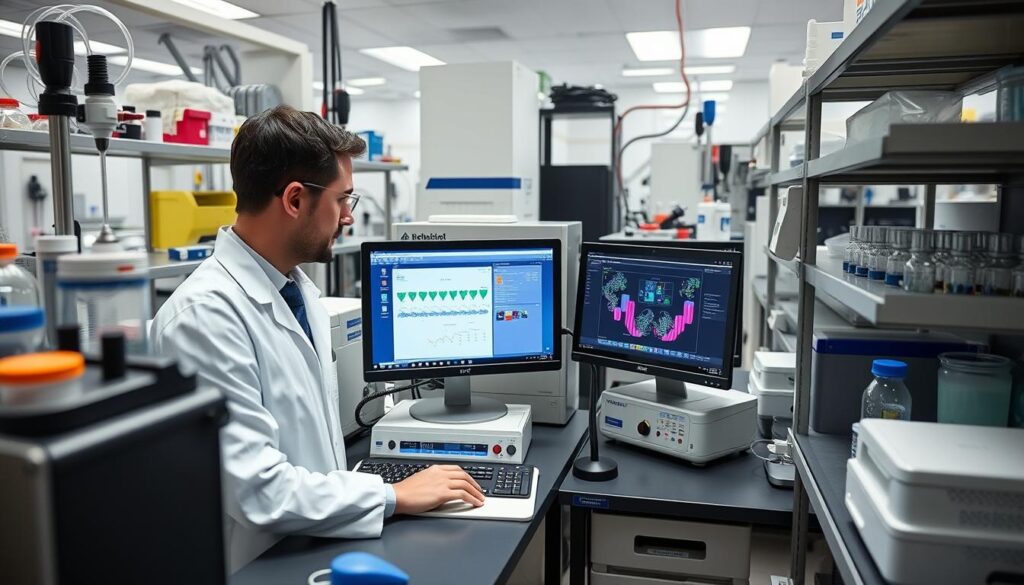
Biotechnology careers often focus on research and development of biological products and processes
Biotechnology Careers
- Research Scientist: Conducts research to develop new biotechnological products and processes in pharmaceutical, agricultural, or industrial settings.
- Bioinformatics Specialist: Analyzes biological data using computational tools to extract meaningful insights for drug discovery, genomics, and other applications.
- Bioprocess Engineer: Designs and optimizes processes for the production of biologics, biofuels, and other biotechnology products at commercial scale.
- Regulatory Affairs Specialist: Ensures compliance with regulations governing biotechnology products, particularly in pharmaceutical and agricultural applications.
- Business Development Manager: Identifies opportunities for commercializing biotechnology innovations and develops strategies for market entry and growth.
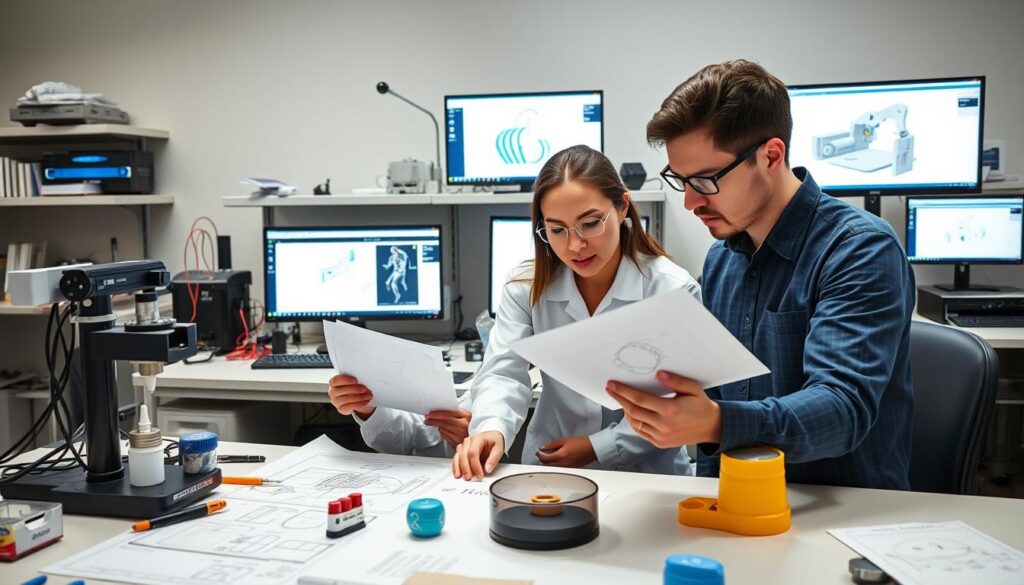
Bioengineering careers often involve designing and developing medical devices and systems
Bioengineering Careers
- Biomedical Engineer: Designs and develops medical devices, prosthetics, imaging systems, and other technologies for healthcare applications.
- Tissue Engineer: Creates artificial tissues and organs for transplantation, drug testing, or disease modeling using biomaterials and cell culture techniques.
- Biomechanical Engineer: Applies mechanical engineering principles to biological systems, developing orthopedic implants, artificial joints, and other biomechanical devices.
- Neural Engineer: Develops technologies that interface with the nervous system, including brain-computer interfaces, neural prosthetics, and neuromodulation devices.
- Clinical Engineer: Works in healthcare settings to ensure the safe and effective use of biomedical equipment and technologies.
The convergence of biotechnology and bioengineering is creating new career opportunities that span both fields. Professionals with interdisciplinary training are increasingly valued for their ability to bridge the gap between biological understanding and engineering application, particularly in emerging areas like synthetic biology, regenerative medicine, and biofabrication.
Discover Your Career Path
Not sure which field aligns better with your interests and goals? Take our career assessment to explore how your skills and preferences match with various roles in biotechnology and bioengineering.
Conclusion: The Future of Biotechnology and Bioengineering

The future will likely see increasingly integrated approaches combining biotechnology and bioengineering principles
As we’ve explored throughout this article, biotechnology and bioengineering represent distinct yet complementary approaches to applying biological knowledge for practical purposes. Biotechnology focuses on harnessing and modifying existing biological systems, while bioengineering applies engineering principles to design and create new biological components and systems.
Despite their differences, these fields are increasingly converging as researchers and practitioners recognize the value of integrating both approaches. This convergence is driving innovations across multiple sectors, from healthcare and agriculture to environmental conservation and industrial manufacturing.
The future of these fields will likely be characterized by even greater integration and interdisciplinary collaboration. As our understanding of biological systems deepens and our engineering capabilities advance, we can expect to see increasingly sophisticated biotechnological and bioengineered solutions to some of humanity’s most pressing challenges.
Whether you’re considering a career in these fields, seeking to understand their impact on society, or simply curious about the science behind today’s biological innovations, appreciating the distinct contributions and growing synergies between biotechnology and bioengineering provides valuable insight into how these disciplines are shaping our world and our future.
Continue Your Exploration
Want to learn more about the exciting developments at the intersection of biotechnology and bioengineering? Explore our comprehensive resource library featuring articles, case studies, and expert interviews.
